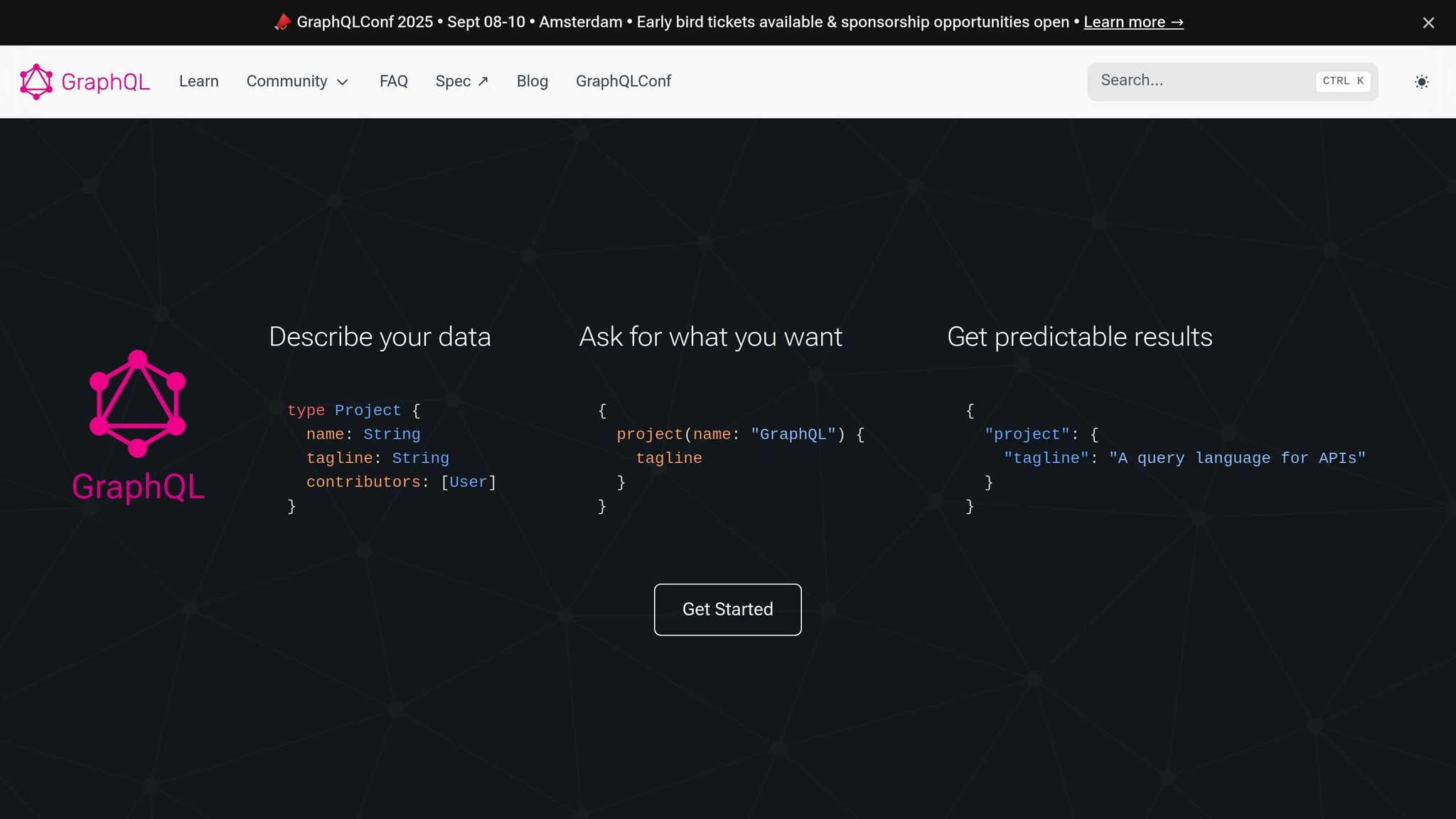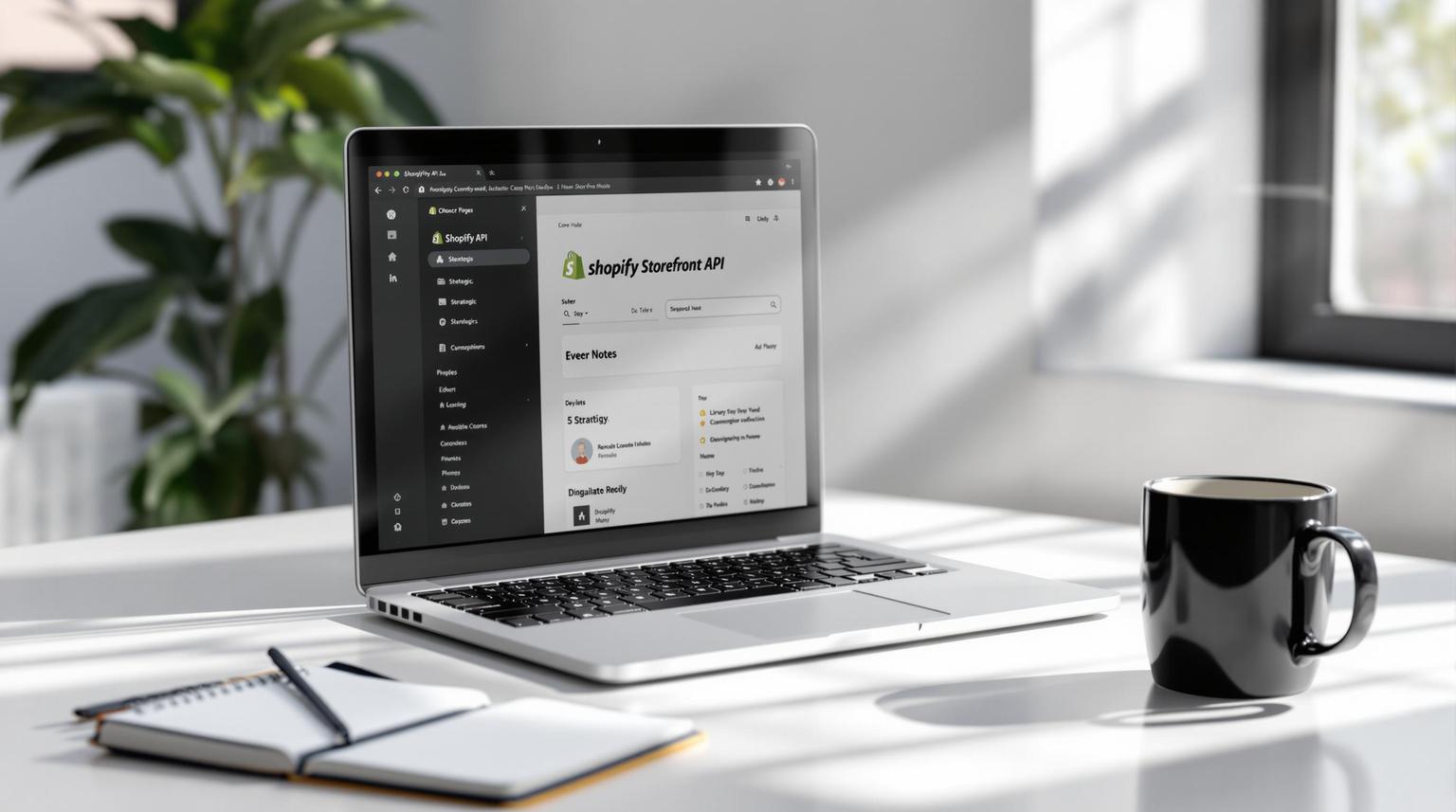Struggling with slow Shopify Storefront API performance? Slow API responses can hurt your e-commerce store, leading to a 53% increase in bounce rates, 38% fewer add-to-cart actions, and 22% lower checkout completions. Every 100ms delay can reduce conversions by 7%.
Here’s how to fix it. This guide covers 5 proven solutions to optimize API performance:
- Optimize API Queries: Reduce response times by 4-6x with smarter GraphQL queries.
- Use Caching: Improve load times by up to 500ms with efficient caching strategies.
- Manage API Rate Limits: Avoid 429 errors with batching, retries, and request scheduling.
- Load Data Selectively: Fetch only what’s needed to cut query costs and speed up responses.
- Track Performance: Monitor key metrics like response time, error rate, and cache hit ratios.
Quick Tip: Start by refining your GraphQL queries and implementing caching for the fastest results. Then, layer on rate limit management and selective data loading for long-term stability. Let’s dive in!
Caching GraphQL APIs

1. Write Better API Queries
Crafting efficient GraphQL queries is key to ensuring your Shopify Storefront API performs well. Poorly designed queries can slow response times and waste API resources.
Before and After: Query Examples
Let’s compare two approaches:
# Inefficient Query
{
products {
edges {
node {
id
title
variants {
edges {
node {
id
price
inventoryQuantity
createdAt
updatedAt
}
}
}
}
}
}
}
Now, check out this optimized version:
# Optimized Query
query ProductList($first: Int!) {
products(first: $first) {
nodes {
id
title
variants(first: 5) {
nodes {
id
price
}
}
}
}
}
The optimized query focuses on retrieving only necessary data, reducing payload size and improving response times.
How to Pick the Right Data Fields
Selecting the right fields is a balancing act between performance and functionality. Use this framework to prioritize:
| Priority | Field Type | Examples |
|---|---|---|
| Critical | Core IDs & Display | product.id, title |
| High | Essential UI Data | price, images |
| Medium | Conditional Fields | inventory |
| Low | Metadata | createdAt, tags |
Focus on high-priority fields to avoid overloading your query with unnecessary data.
Using Query Variables
Query variables make your queries both flexible and efficient. Here’s an example:
query GetProduct($id: ID!, $variantsFirst: Int!) {
product(id: $id) {
title
variants(first: $variantsFirst) {
nodes {
price
}
}
}
}
By using variables, you can adapt queries to different scenarios without hardcoding values. This approach can lead to tangible improvements - one case reported a 60% boost in cache reuse and 42% reduction in memory usage.
While optimizing queries is a great start, leveraging cached responses can take performance to the next level - stay tuned for that in the next section.
2. Set Up API Caching
Optimized queries are great for cutting down payload size, but caching takes it to the next level by reducing the need for repeat requests.
Why Caching Matters
Caching helps lighten server load and speeds up user interactions. For example, merchants have reported up to 500ms improvements in time-to-first-byte metrics after fine-tuning their caching systems. This paves the way for smarter, layered caching approaches that keep data both quick and current.
How to Add Caching to Shopify

Here’s how to handle caching for different types of data:
| Data Type | Caching Strategy | TTL Duration |
|---|---|---|
| Product Listings | Query Result Cache | 5–15 minutes |
| UI Components | Fragment Cache | 24 hours |
| Marketing Pages | Full Page Cache | 1 week |
| User Data | Session Cache | Session length |
To make this work seamlessly, focus on these key steps:
- Set up in-memory caching: Use tools like Redis or Memcached to store frequent GraphQL query results.
- Use CDN-level caching: Services like Cloudflare can handle static assets efficiently. Adjust
Cache-Controlheaders to match how often your content updates.
Keeping Your Cache Accurate
To ensure data stays up-to-date, follow these strategies:
- Dynamic data: Set short TTLs (30–60 seconds) for things like inventory or pricing.
- Critical updates: Use product or webhook events to trigger cache purges when changes occur.
Monitor Cache Effectiveness: Keep an eye on metrics like cache hit rates (aim for over 80%), response time percentiles, and reductions in API calls. These directly tie back to the performance boosts discussed earlier.
3. Manage API Request Limits
Although Shopify's Storefront API doesn't have official rate limits, developers often face practical constraints due to HTTP connection limits and backend restrictions. While caching can help reduce repetitive requests (as discussed earlier), managing your API requests effectively is key to avoiding slowdowns.
Combine Multiple API Requests
GraphQL allows you to group multiple data requests into a single HTTP call, cutting down on server load and speeding up responses. Here's an example of how you can structure a batched query:
const {data} = await queryShop({
query: `{
shop { name }
products(first:10) { edges { node { id } } }
collections(first:5) { edges { node { id } } }
}`
});
This approach minimizes the number of API calls and streamlines data retrieval.
Handle Rate Limit Errors
If you hit a 429 (Too Many Requests) error, a solid retry strategy can help. Here's a simple framework:
| Component | Implementation |
|---|---|
| Initial Delay | Start with 1 second |
| Backoff Strategy | Double the delay with each attempt |
| Max Attempts | Limit to 3 attempts |
For critical operations, consider implementing a fallback mechanism:
async function safeRetry(fn, maxAttempts = 3) {
let attempt = 0;
while (attempt < maxAttempts) {
try {
return await fn();
} catch (error) {
if (!isRetryable(error)) throw error;
await delay(Math.pow(2, attempt));
attempt++;
}
}
}
This ensures your application can gracefully recover from temporary rate limit issues.
Schedule API Requests
Organizing your API requests can help you avoid hitting limits altogether. Assign priorities to requests and schedule them accordingly. For example:
queryShop({
query: CART_QUERY,
context: {
priority: 'high',
timeout: 5000
}
});
For background tasks, you can use the browser's native scheduler API:
scheduler.postTask(() => fetchAPI(), { priority: 'background' });
Keep an eye on these metrics for smooth performance:
- Keep concurrent connections below 50.
- Set alerts for queue times exceeding 200ms.
- Track the complexity of your GraphQL queries.
sbb-itb-454ea9e
4. Load Data Selectively
Selective data loading is an effective way to boost your Shopify storefront's performance. It tackles the issue of fetching unnecessary data, which we discussed earlier, and works hand-in-hand with the query optimization methods from Section 1.
Comparing Data Loading Approaches
Here's how selective loading stacks up against other methods in terms of performance:
| Loading Method | Response Time | Bandwidth Usage | Query Cost Points |
|---|---|---|---|
| Full Loading | ~800ms | High | 45 points/query |
| Selective Loading | ~120ms | Low | 12 points/query |
| Lazy Loading | ~200ms | Optimized | 15-20 points/query |
The goal with selective loading is simple: fetch only the data a component actually needs. For instance, when showing a product catalog, avoid pulling full product details. Instead, focus on key fields needed for display:
fragment ProductCard on Product {
id
title
featuredImage {
url
}
priceRange {
minVariantPrice {
amount
}
}
}
How to Implement Selective Loading in Shopify Hydrogen
To make this work in Hydrogen, follow these steps:
-
Set Up Server Components
Begin with server components that use specific, targeted queries. -
Use
useShopQueryfor Dynamic Updates
Here's an example of how to fetch product data dynamically:const {data} = useShopQuery({ query: PRODUCT_CARD_QUERY, variables: { first: 10, sortKey: 'BEST_SELLING' } }); -
Add Caching Layers
Proper caching ensures efficient retrieval of frequently accessed data.
To track your improvements, check Time-to-First-Byte (TTFB) metrics using tools like Shopify's GraphiQL Explorer and the Chrome DevTools Network panel.
5. Track API Performance
Selective loading (as discussed in Section 4) is great for optimizing initial performance, but keeping that performance steady over time is just as important. Regular monitoring ensures your APIs can handle traffic spikes and content updates without slowing down. Without this, you risk checkout completion rates dropping by 22%, as mentioned earlier, if response times exceed 500ms.
What to Measure
To keep your API running smoothly, pay attention to these key metrics:
| Metric | Target Threshold | Why It Matters |
|---|---|---|
| Response Time | Less than 500ms | Faster responses boost conversions |
| Error Rate | Below 2% (5xx errors) | Impacts user experience |
| API Call Quota | Under 800 points/sec | Avoids rate-limiting issues |
| Cache Hit Ratio | Over 85% | Reduces server load |
Among these, query cost consumption is a standout metric. Shopify's GraphQL API allows 1000 points per second, and monitoring this ensures your system can handle peak traffic without hiccups.
Set Up Performance Alerts
To stay ahead of potential issues, configure these critical alerts:
- Rate Limit Warnings: Set notifications for when your API usage hits 80% of the 1000 points/second limit. This gives you time to adjust before reaching the cap.
- Response Time Monitoring: Trigger alerts for queries taking longer than 500ms. Shopify data shows that tracking response times led to a 3x improvement in rendering speed for GraphQL Storefront API queries.
- Error Rate Tracking: Keep an eye on 5xx errors and set alerts if they exceed 2% of requests. This ensures stable performance even during heavy traffic.
Performance Tracking Tools
Shopify provides built-in tools and supports third-party integrations to help you monitor your API effectively:
- Shopify Observe: Offers real-time query analysis and has been shown to improve performance by up to 5x.
-
Third-Party Tools:
Tool Benefit Datadog APM Includes custom Shopify API templates PageSpeed Insights Links API performance to user experience
A great example comes from Wiser, which reduced API calls by 40% through consistent monitoring. Effective tracking isn't just about avoiding problems - it's about staying ahead of them.
Conclusion: Put These Solutions to Work
How These Solutions Help
The five API optimization techniques we’ve discussed can work together to significantly boost your Shopify storefront’s performance. Here’s a quick look at how each approach contributes:
| Solution | Benefit |
|---|---|
| Query Optimization | Cuts response times by 80% |
| API Caching | Increases conversion rates by 6% |
| Rate Limit Management | Avoids 429 errors and keeps usage below 70% of limits |
| Selective Loading | Achieves GraphQL rendering speeds up to 3x faster |
| Performance Tracking | Delivers 5x better performance using Shopify Observe |
Steps to Get Started
To apply these techniques, begin with query optimization as described in Section 1. Shopify’s 2020 API performance benchmarks provide a great framework for implementation. Follow these steps:
- Refine your queries using Shopify’s GraphQL cost calculator to minimize unnecessary data loads.
- Use caching strategically based on your store’s scale (Hydrogen for smaller stores, distributed systems for larger operations).
- Plan your requests to stay within the API rate limits of your Shopify plan.
Together, these adjustments can help address the 22% checkout completion drop mentioned earlier.
Ongoing Monitoring Plan
To maintain performance improvements, set up regular monitoring checkpoints. Here’s a handy schedule:
| Frequency | Action | Goal |
|---|---|---|
| Weekly | Review cache usage | Achieve over 80% hit rate |
| Monthly | Audit API rate usage | Stay below 70% of limits |
| Quarterly | Conduct load tests | Ensure responses under 500ms |
These steps, combined with tools like Shopify’s Observe dashboard, will help keep your storefront running smoothly and efficiently.
FAQs
What is the leaky bucket algorithm in Shopify?
Shopify uses a legacy rate-limiting system to manage server load while offering flexibility in API usage. Here's a quick breakdown:
| Parameter | Value |
|---|---|
| Bucket Size | 40 calls |
| Leak Rate | 2 calls/second |
| Recovery Time | 20 seconds |
For example, if you make 35 rapid API calls, the bucket fills to 35 out of its 40-call capacity. The system then processes 2 calls per second, gradually reducing the bucket's load and ensuring the server isn't overwhelmed.
This ties into the rate limit strategies discussed earlier in Section 3, where combining requests and using smart retry logic were highlighted as effective methods.
What's the most effective way to handle rate limit errors?
To manage rate limit errors efficiently, consider these strategies:
- Queue requests based on their importance to your business.
- Focus on critical requests during periods of high traffic.
- Continuously monitor system capacity to prevent overload.
Studies show that using this approach can keep error rates below 1% even during peak traffic times.


